(完整版)不定式和动名词作主语的区别
动名词与不定式的区别
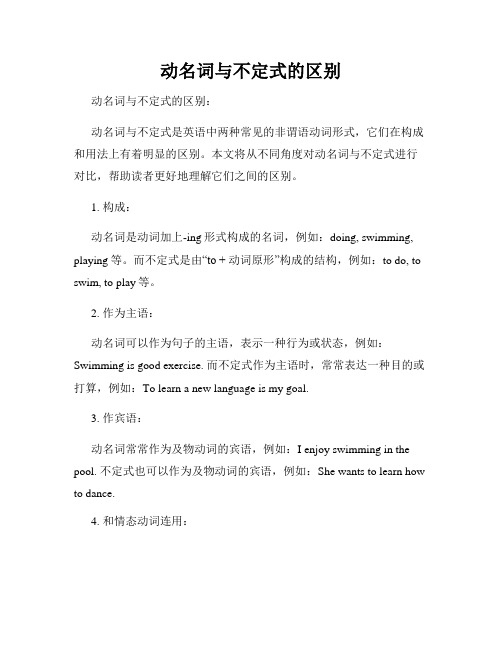
动名词与不定式的区别动名词与不定式的区别:动名词与不定式是英语中两种常见的非谓语动词形式,它们在构成和用法上有着明显的区别。
本文将从不同角度对动名词与不定式进行对比,帮助读者更好地理解它们之间的区别。
1. 构成:动名词是动词加上-ing形式构成的名词,例如:doing, swimming, playing等。
而不定式是由“to + 动词原形”构成的结构,例如:to do, to swim, to play等。
2. 作为主语:动名词可以作为句子的主语,表示一种行为或状态,例如:Swimming is good exercise. 而不定式作为主语时,常常表达一种目的或打算,例如:To learn a new language is my goal.3. 作宾语:动名词常常作为及物动词的宾语,例如:I enjoy swimming in the pool. 不定式也可以作为及物动词的宾语,例如:She wants to learn how to dance.4. 和情态动词连用:当动名词和情态动词连用时,情态动词后面必须跟动名词形式,例如:I can't stand smoking. 而不定式和情态动词连用时,情态动词后跟不定式的原形,例如:She must study hard to pass the exam.5. 表达目的:动名词常用来表达一个动作或状态的目的,例如:I went to the gym for swimming. 而不定式也可以表达目的,例如:She walked fast tocatch the bus.通过以上对比,我们可以清楚地看到动名词与不定式在用法上的区别。
在实际运用中,我们需要根据句子的语境和需要选择合适的形式,以确保句子表达准确清晰。
希望本文的对比能帮助读者更好地理解动名词与不定式之间的区别,提高英语写作和表达的能力。
不定式和动名词的区别
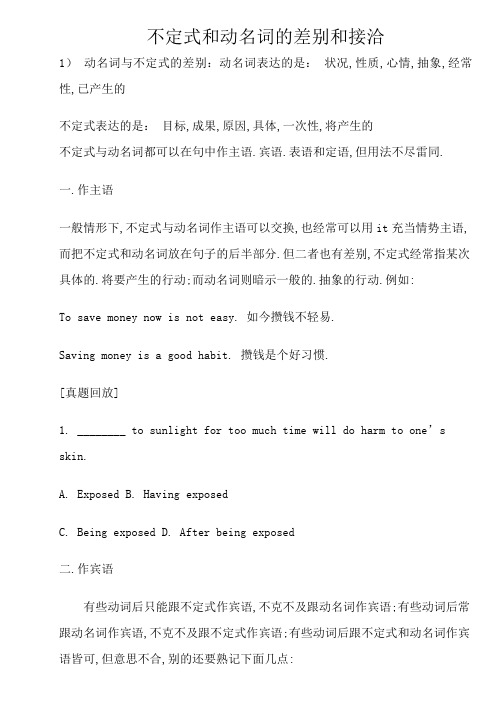
不定式和动名词的差别和接洽1)动名词与不定式的差别:动名词表达的是:状况,性质,心情,抽象,经常性,已产生的不定式表达的是:目标,成果,原因,具体,一次性,将产生的不定式与动名词都可以在句中作主语.宾语.表语和定语,但用法不尽雷同.一.作主语一般情形下,不定式与动名词作主语可以交换,也经常可以用it充当情势主语,而把不定式和动名词放在句子的后半部分.但二者也有差别,不定式经常指某次具体的.将要产生的行动;而动名词则暗示一般的.抽象的行动.例如:To save money now is not easy. 如今攒钱不轻易.Saving money is a good habit. 攒钱是个好习惯.[真题回放]1. ________ to sunlight for too much time will do harm to one’s skin.A. ExposedB. Having exposedC. Being exposedD. After being exposed二.作宾语有些动词后只能跟不定式作宾语,不克不及跟动名词作宾语;有些动词后常跟动名词作宾语,不克不及跟不定式作宾语;有些动词后跟不定式和动名词作宾语皆可,但意思不合,别的还要熟记下面几点:1)下列短语中的to是介词,厥后跟动名词,不跟不定式.be(get) used to习惯于;look forward to希望;pay attention to留意;get down to开端卖力做;lead to通向.导致;prefer doing ... to doing ...情愿做……而不肯做……;stick to保持;devote one’s life(time, oneself) to献身于.致力于;object to否决;in addition to ...除……之外;on the way to ...在去……的路上.刚要成为……;等等.2)不定式除可用在except, but, besides等后作宾语之外,一般不必作介词宾语.此时,不定式可否省略to,取决于其前是否有行动动词do或其响应情势.有则省略,无则不克不及省略.例如:She did nothing but wash some clothes that day. 那天她除了洗一些衣服之外什么也没做.We had no choice except to walk home. 除了走着回家我们别无选择.3) 动名词除了其一般式doing,还有完成式having done以及一般式的自动情势being done和完成式的自动情势having been done;动名词前可以加上逻辑主语,组成动名词的复合构造:sb.’s doing.例如:I’m sorry for not having kept my promise.异常抱愧,我没能遵照诺言.(not having kept my promise产生在am sorry之前)Do you mind Mary being left alone at home?你介怀玛丽被单独一小我留在家里吗?4) 不定式的完成式to have done暗示在谓语动词之前已经产生的动作,而不定式的一般式to do暗示动作将要产生.不定式还有其自动情势:to bedone(暗示将来的自动动作)和to have been done(暗示曩昔的自动动作).三.作表语不定式与动名词作表语时的差别与作主语时雷同.例如:My job is teaching English. 我的工作是教英语.(泛指,多次性抽象行动) Your task is to go and help the farmers.你的工作是去帮忙那些农平易近.(特指,一次性具体行动)四.作定语不定式多为后置定语,动名词多为前置定语;不定式多暗示将来的动作,动名词只能暗示事物的属性.用处等.例如:He is looking for a room to live in.他正在找一间房子去住.Take these sleeping pills and you’ll sleep better. 吃了这种安眠药,你会睡得更好.留意:不定式作定语时平日与其前的名词(代词)组成动宾关系.假如作定语的不定式是不及物动词,厥后平日要加上响应的介词.例如:Please give me a knife with which to cut.2)鄙人列情形下,一般要用不定式:①hate,like,love前有would(should)时,如:I'd like to have a cup of coffee.②当谓语动词begin,continue,start等是进行式时,如:Thestudents arestarting to work on the diffic ult math’s problem.③begin,continue,start与know,understand等状况动词连用时,如:I soon began to understand what was happening.⒋advise,allow,encourage,forbid,permit等动词后接动名词作宾语,或带不定式作宾语补足语.如:Our teachers don't permit our/us swimming in the lake. Our teachers don't permit us to swim in the lake. 3)部分动词后接不定式或动名词时,意义不同较大,应依据句子语境选择应用.①forget,remember,regret后接不定式,暗示如今或将来的动作,接动名词暗示动作已经产生.如:Don't forget to post the letter for me. Have you forgotten meeting her in BeijingAirport? Remember to close the windows before you leave.I remember writing him a letter a year ago. We regret to tell you that all of you are not invited toattend the meeting.They regretted ordering these books from abroad. 动名词与不定式语义不合的有11 组: 1 forget doing/to do forget to do忘却要去做某事.(未做) forget doing忘却做过某事.(已做) The light in the office is stil on. He forgot to turn it off. 办公室的灯还在亮着,它忘却关了.(没有做关灯的动作) He forgot turning the light off. 他忘却他已经关了灯了.( 已做过关灯的动作) Don't forget to come tomorrow.别忘了明天来.(to come动作未做) 典范例题---- The light in the office is still on. ---- Oh,I forgot___.A. turning it offB. turn it offC. to turn it offD. having turned it off 答案:C.由the light is still on 可知灯亮着,即关灯的动作没有产生,是以用forget to do sth. 而forget doing sth暗示灯已经关上了,而本身忘却了这一事实.此处不相符题意 2 stop doing/to do stop to do停滞,中止本来做的事,开端做别的一件事stop doing停滞正在做的事They stop to smoke a cigarette. 他们停下来,抽了根烟.I must stop smoking..我必须戒烟了. 典范例题 She reached the top of the hill and stopped ___on a big rock by the side of the path.A. to have restedB. restingC. to restD. rest 答案:C.由题意可知,她到了山顶,停下来在一个路边的大石头上歇息.是以,应选择"stop to do sth. 停下往来来往做另一件事".而不但仅是登山动作的终止,所以stop doing sth.不准确.3 remember doing/to do remember to do 记得去做某事(未做) remember doing记得做过某事(已做)Remember to go to the post office after school. 记住下学后去趟邮局. Don't you remember seeing the man before? 你不记得以前见过那小我吗?4 regret doing/to do regret to do 对要做的事圆满.(未做) regret doing 对做过的事圆满.懊悔.(已做) I regret to have to do this, but I have no choice. 我很圆满必须如许去做,我其实没有方法.I don't regret telling her what I thought. 我不为告知她我的设法主意尔懊悔. 典范例题---You were brave enough to raise objections at the meeting. ---Well, now I regret ___ that.A. to doB. to be doingC.to have doneD.having done 答案:D.regret having done sth. 对已产生的事觉得圆满.regret to do sth.对将要做的事觉得圆满.本题为对已说的话觉得懊悔,是以选 D.5 cease doing/to do cease to do 长时光,甚至永久停做某事. cease doing 短时停滞做某事,今后还会接着做. That department has ceased to exist forever. 谁人部分已不复消失. The girls ceased chatting for a moment when their teacher passed by. 姑娘们在先生走过时,停了会谈天.6 try doing/to do try to do尽力,妄图做某事.try doing 实验,试着做某事. You must try to be more careful. 你可要多加当心.I tried gardening but didn't succeed. 我试着种果木花草,但未成功.7 go on doing/to do go on to do做了一件过后,接着做另一件事. go on doing 持续做本来做的事. After he had finished his math,he went on to do his physics. 做完数学后,他接着去做物理. Go on doing the other exercise after you have finished this one. 作完这个演习后,接着做其他的演习8 be afraid doing/to do be afraid to do不敢,胆怯去做某事,是主不雅上的原因不去做,意为"怕"; be afraid of doing放心消失doing的状况.成果. doing 是客不雅上造成的,意为"生怕,生怕". She was afraid to step further in grass because she was afraid of beingbitten by a snake. 她生怕被蛇咬着,而不敢在草丛中再走一步. She was afraid to wake her husband. 她不敢去唤醒她丈夫. She was afraid of waking her husband. 她生怕吵醒她丈夫. .9 be interested doing/to dointerested to do 对做某事感兴致,想懂得某事. interested in doing 对某种设法主意感兴致,doing 平日为设法主意.I shall be interested to know what happens. 我很想知道产生了什么事. (想懂得) I'm interested in working in Switzerland. Do you have any idea about that?我对在瑞士工作感兴致.你想过这事吗? (一种设法主意)10 mean to doing/to domean to do 打算.想要做某事mean doing意味着要有一个成果I mean to go, but my father would not allow me to. 我想去,但是我父亲不肯让我去. To raise wage means increasing purchasing power. 赠加工资意味着增长购置力.11 begin(start) doing/to do begin / start to do sth begin / start doing sth.1)谈及一项长期运动或开端一种习惯时,应用doing. How old were you when you first started playing the piano? 你几岁时开端弹钢琴?2)begin, start用进行不时,后面动词用不定式to doI was beginning to get angry. 我开端生起气来.3)在attempt, intend, begin, start 后接know, understand, realize这类动词时,经常应用不定式todo.I begin to understand the truth. 我开端明确本相.4)物作主语时,常应用不定式to do. It began to melt.1. The teacher told them ________ make so much noise.A. don’tB. notC. will notD. not to2. Our master often told us _______ things for granted.A. not to haveB. not to takeC. didn’t takeD. not to make3. Tell him _______ the window.A. to shut notB. not to shutC. to not shutD. not shut4. The boy wanted to ride his bicycle in the street, but his mother told him ______.A. not toB. not to doC. not do itD. do not to5. Mrs Smith warned her daughter ________ after drinking.A. never to driveB. to never driveC. never drivingD. never drive6. The patient was warned _______ oily food after the operation.A. to eat notB. eating notC. not to eatD. not eating7. The workers want us ________ together with them.A. workB. workingC. to workD. worked8. They would not allow him ________ across the enemy line.A. to risk goingB. risking to goC. for risk to goD. risk going9. I saw him _______ out of the room.A. goB. had goneC. has goneD. goes10. They knew her very well. They had seen her _______ up from childhood.A. growB. grewC. was growingD. to grow11. I’ve heard him _______ about you often.A. spokeB. speaksC. speak12. Though he had often made his little sister _____, today he was made _____by his little sister.A. cry;to cryB. crying;cryingC. cry;cryD. to cry;cry13. This company was the first ____ portable radios as well as cassette tape recorders in the world.A. producingB. to produceC. having producedD. produced14. The purpose of new technology is to make life easier, ____it more difficult.A .not making B. not make C .not to make D. nor to make15. The news reporters hurried to the airport, only ______the film stars had left.A .to tellB .to be toldC .tellingD .told16. There’re so many kinds of tape-recorders on sale that Ican’t make up my mind _____ to buy.A. whatB. whichC. howD. where17. There is n’t any difference between the two. I really don’t know _________.A. where to chooseB. which to chooseC. to choose whatD. to choose which18. “ Have you decided when ________?” “ Yes, tomorrow morning.”A. to leaveB. to be leavingC. will you leaveD. are you leaving19. Last summer I took a course on ________.A. how to make dressesB. how dresses be madeC. how to be made dressesD. how dresses to be made20. He doesn’t know ______ to stay or not.A. whetherB. ifC. eitherD. if he will21. She pretended _______ me when I passed by.A. not to seeB. not seeingC. to not seeD. having not seen22. --- The light in the office is still on. --- Oh, I forgot _______.A. turning it offB. turn it offC. to turn it offD. having turned it off23. We agreed _________ here but so far she hasn’t turned up yet.A. having metB. meetingC. to meetD. to have met24You were silly not _______your car.A. to lockB. to have lockedC. lockingD. having locked25. The teacher asked us ______so much noise.A .don’t make B. not make C. not making D .not to make1. Helen had to shout ____ above the sound of the music.A. making herself hearB. to make herself hearC. making herself heardD. to make herself heard2. Reading is an experience quite different from watching TV; there are pictures ___ in your mind instead of before your eyes.A. to formB. formC. formingD. having formed3. The man insisted ___ a taxi for me even though I told him I lived nearby.A. findB. to findC. on findingD. in finding4. The old man, ____ abroad for twenty years, is on the way back to his motherland.A. to workB. workingC. to have workedD. having worked5. You were silly not ___ your car.A. to lockB. to have lockedC. lockingD. having locked6. Don’t leave the water ___ while you brush your teeth.A. runB. runningC. being runD. to run7. When flint (电石) ___ to the market, these products enjoyed great success.A. introducingB. introducedC. introduceD. being introduced8. “We can’t go out in this weather,” said Bob, ____ out of the window.A. lookingB. to lookC. lookedD. having looked9. My advisor encouraged ___ a summer course to improve my writing skills. A. for me taking B. me taking C. for me to take D. me to take10. ____ in the queue for half an hour, Tom suddenly realized that he had left his wallet at home.A. To waitB. Have waitedC. Having waitedD. To have waited11. Linda worked for the Minnesota Manufacturing and Mining Company, ________ as 3M.A. knowingB. knownC. being knownD. to be known12. Sarah, hurry up. I’m afraid you can’t have time to ____ before the party.A. get changed*B. get changeC. get changingD. get to change13. ____ by the beauty of nature, the girl from London decided to stay another two days off the farm.A. AttractingB. AttractedC. To be attractedD. Having attracted14. I don’t know whether you happen ____ that I’m going to study in the U. S. A. this September.A. to be heardB. to be hearingC. to hearD. to have heard15. The news reporters hurried to the airport, only___ the film stars had left.A. to tellB. to be toldC. tellingD. told16. Having been ill in bed for nearly a month, he had a hard time _____ the exam.A. passB. to passC. passedD. passing17. ____ with the size of the whole earth, the biggest ocean doesn’t seem big at all.A. CompareB. When comparingC. ComparingD. When compared18. ____ the program, they have to stay there for another two weeks.A. Not completingB. Not completedC. Not having completedD. Having not completed19. If you are planning to spend your money having fun this week,better ___ it—you’ve got some big bills coming.A. forgetB. forgotC. forgettingD. to forget20. According to a recent U. S. survey, children spend up to 25 hours a week ___ TV.A. to watchB. to watchingC. watchingD. watch21. The flu is believed ____ by viruses(病毒)that like to reproduce in the cells inside the human nose and throat.A. causeB. being causedC. to be causedD. to have caused22. The flowers____ sweet in the botanic garden attract the visitors to the beauty of nature.A. to smellB. smellingC. smeltD. to be smelt23. The disc, digitally ____ in the studio, sounded fantastic at the party that night.A. recorded *B. recordingC. to be recordedD. having recorded24. Having been attacked by terrorists, ____ .A. doctors came to their rescueB. the tall building collapsedC. an emergency measure was takenD. warnings were given to tourists25. Robert is said ________ abroad, but I don’t know what country he studied in.A. to have studiedB. to studyC. to be studyingD. to have been studying26. The managers discussed the plan that they would like to see ________ the next year.A. carried outB. carrying outC. carry outD. to carry out27. I’ve worked with child before, so I know what ________ in mynew job. A. expected B. to expect* C. to be expecting D. expect28. ________ such heavy pollution already, it may now be too late to clean up the river.A. Having sufferedB. SufferingC. To sufferD. Suffered29. Having a trip abroad is certainly good for the old couple, but it remains _____ whether they will enjoy it.A. to seeB. to be seenC. seeingD. seen30. The research is so designed that once ________ nothing can be done to change it.A. beginsB. having begunC. beginningD. begun。
不定式和动名词作主语区别
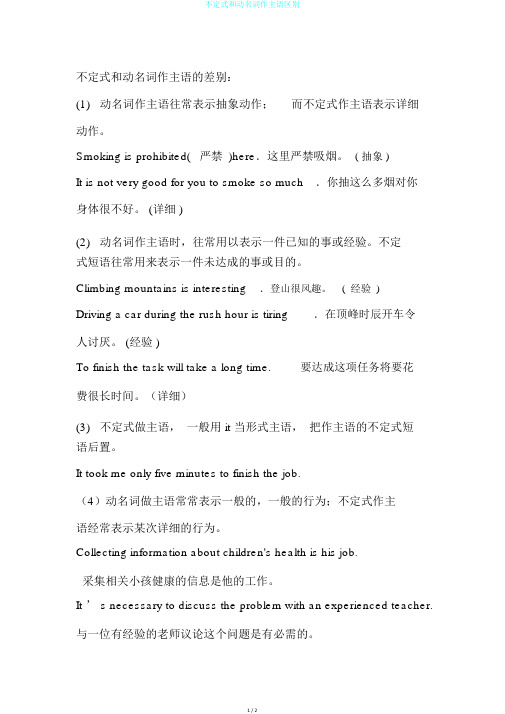
不定式和动名词作主语的差别:(1)动名词作主语往常表示抽象动作;而不定式作主语表示详细动作。
Smoking is prohibited(严禁)here.这里严禁吸烟。
( 抽象 )It is not very good for you to smoke so much.你抽这么多烟对你身体很不好。
(详细 )(2)动名词作主语时,往常用以表示一件已知的事或经验。
不定式短语往常用来表示一件未达成的事或目的。
Climbing mountains is interesting.登山很风趣。
(经验)Driving a car during the rush hour is tiring.在顶峰时辰开车令人讨厌。
(经验 )To finish the task will take a long time.要达成这项任务将要花费很长时间。
(详细)(3)不定式做主语,一般用 it 当形式主语,把作主语的不定式短语后置。
It took me only five minutes to finish the job.(4)动名词做主语常常表示一般的,一般的行为;不定式作主语经常表示某次详细的行为。
Collecting information about children's health is his job.采集相关小孩健康的信息是他的工作。
It ’ s necessary to discuss the problem with an experienced teacher. 与一位有经验的老师议论这个问题是有必需的。
2、常用不定式做主语的句型有:(1)It ’ s difficult (important, necessary) for sb. to do(2)It ’ s kind (good, friendly, polite, careless, rude, cruel, clever, foolish, brave) of sb. to do.3、常用动名词做主语的句型有:It ’ s no good (use, fun) doing.It ’ s (a) waste of time one’ s doing.。
高中英语---不定式和动名词做主语的区别

不定式和动名词作主语的区别非谓语动词除了不能独立作谓语外,可以承担句子的其他成分,如主语、宾语、表语、定语、补语。
非谓语动词中,不定式和动名词都可以做主语,也都可以借助于it把不定式和动名词移到句子后面。
一般来说,不定式作主语,表示具体的、一次性的或将来的动作;动名词作主语,表示一般的、泛指的或习惯性的行。
如:Smoking is prohibited(禁止)here .这里禁止抽烟.(抽象)It is not very good for you to smoke so much .你抽这么多烟对你身体很不好.(具体)通常只用不定式作主语的5种情况:1.It is necessary/important /impossible/ difficult •…(fob. ) to do sth. 句型如:It is necessary for us to master a foreign Ianguage. 我们有必要掌握一门夕卜语2.It is kind /foolish/clever/stupid/nice/rude/careless/friendly sb. ) to・doofth .句型,形容词常修饰人的特征如:It is very kind of you to help us. 你帮助我们真是太好了3. It takes/cost/require/make sb./sth. to do sth. 句型如It took me two hours to finish the work. 我完成那项工作用了两小时4. 不定式和when/where/how/what/whether 等连用,在句子中做主语如:Whether to do it hasn t been decided.是否去做还没有决定5. 主语被否定时如:Not to have hope is the poorest of all conditions. 绝望是最糟糕的事通常只用动名词用主语的6种情况:1. 含形容词的句子,It is good/foolish/wo nderful/ useless/ difficult /nice doing句型中如:It is useless try again. 再试也没用2. 含名词的句子,It is no fun/luck/pleasure/relief/mistake/pai n/use/good 句型中女口: It is no use waiting here doing nothing. 无所事事地等待是没有用的3. There is no (use/help/need) doing sth 句型如:There is no knowing what may happen in that case. 女口果那样的话不知道会发生什么事4. 在疑问句中如:Is doing morning exercises good for your health? 做早操对身体有益处吗?5. 在某些动词的被动式前如:Walking on the grass is forbidden. 禁止在这草地上行走。
动名词和不定式做主语的区别
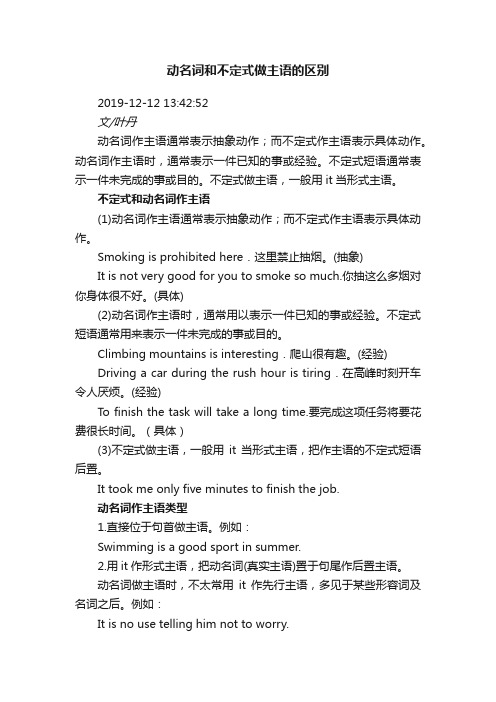
动名词和不定式做主语的区别2019-12-12 13:42:52文/叶丹动名词作主语通常表示抽象动作;而不定式作主语表示具体动作。
动名词作主语时,通常表示一件已知的事或经验。
不定式短语通常表示一件未完成的事或目的。
不定式做主语,一般用it当形式主语。
不定式和动名词作主语(1)动名词作主语通常表示抽象动作;而不定式作主语表示具体动作。
Smoking is prohibited here.这里禁止抽烟。
(抽象)It is not very good for you to smoke so much.你抽这么多烟对你身体很不好。
(具体)(2)动名词作主语时,通常用以表示一件已知的事或经验。
不定式短语通常用来表示一件未完成的事或目的。
Climbing mountains is interesting.爬山很有趣。
(经验)Driving a car during the rush hour is tiring.在高峰时刻开车令人厌烦。
(经验)To finish the task will take a long time.要完成这项任务将要花费很长时间。
(具体)(3)不定式做主语,一般用it当形式主语,把作主语的不定式短语后置。
It took me only five minutes to finish the job.动名词作主语类型1.直接位于句首做主语。
例如:Swimming is a good sport in summer.2.用it作形式主语,把动名词(真实主语)置于句尾作后置主语。
动名词做主语时,不太常用it 作先行主语,多见于某些形容词及名词之后。
例如:It is no use telling him not to worry.常见的能用于这种结构的形容词还有:better,wonderful,enjoyable,interesting,foolish,difficult,useless,senseless,worthwhile,等。
动名词和不定式作主语的比较
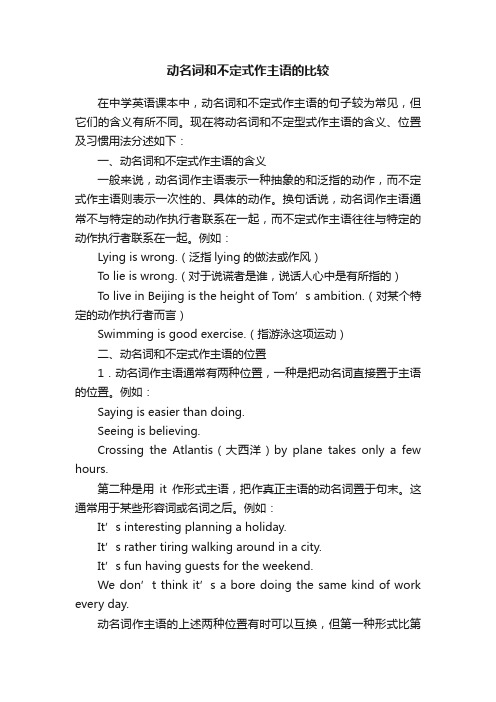
动名词和不定式作主语的比较在中学英语课本中,动名词和不定式作主语的句子较为常见,但它们的含义有所不同。
现在将动名词和不定型式作主语的含义、位置及习惯用法分述如下:一、动名词和不定式作主语的含义一般来说,动名词作主语表示一种抽象的和泛指的动作,而不定式作主语则表示一次性的、具体的动作。
换句话说,动名词作主语通常不与特定的动作执行者联系在一起,而不定式作主语往往与特定的动作执行者联系在一起。
例如:Lying is wrong.(泛指lying的做法或作风)To lie is wrong.(对于说谎者是谁,说话人心中是有所指的)To live in Beijing is the height of Tom’s ambition.(对某个特定的动作执行者而言)Swimming is good exercise.(指游泳这项运动)二、动名词和不定式作主语的位置1.动名词作主语通常有两种位置,一种是把动名词直接置于主语的位置。
例如:Saying is easier than doing.Seeing is believing.Crossing the Atlantis(大西洋)by plane takes only a few hours.第二种是用it作形式主语,把作真正主语的动名词置于句末。
这通常用于某些形容词或名词之后。
例如:It’s interesting planning a holiday.It’s rather tiring walking around in a city.It’s fun having guests for the weekend.We don’t think it’s a bore doing the same kind of work every day.动名词作主语的上述两种位置有时可以互换,但第一种形式比第二种形式的泛指意义更强些。
例如:Lining in Beijing must be wonderfulIt must be wonderful living in Beijing2.不定式作主语通常也有两种位置,与动名词作主语时的位置相同,即第一种是把不定式作直接置于句首担任主语。
动词不定式和动名词的区别与应用
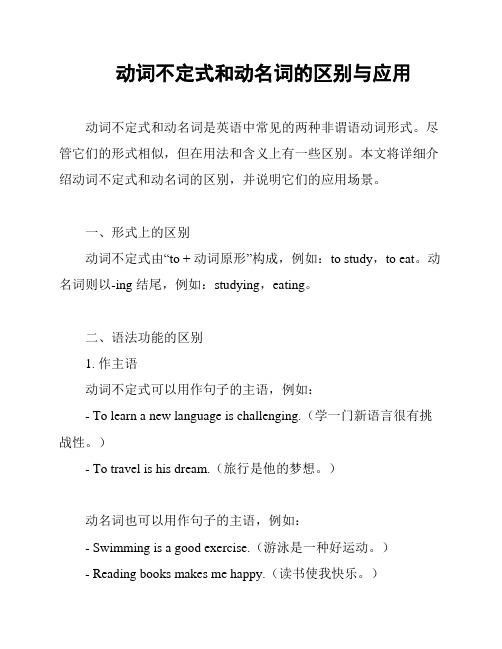
动词不定式和动名词的区别与应用动词不定式和动名词是英语中常见的两种非谓语动词形式。
尽管它们的形式相似,但在用法和含义上有一些区别。
本文将详细介绍动词不定式和动名词的区别,并说明它们的应用场景。
一、形式上的区别动词不定式由“to + 动词原形”构成,例如:to study,to eat。
动名词则以-ing 结尾,例如:studying,eating。
二、语法功能的区别1. 作主语动词不定式可以用作句子的主语,例如:- To learn a new language is challenging.(学一门新语言很有挑战性。
)- To travel is his dream.(旅行是他的梦想。
)动名词也可以用作句子的主语,例如:- Swimming is a good exercise.(游泳是一种好运动。
)- Reading books makes me happy.(读书使我快乐。
)2. 作宾语动词不定式可以用作及物动词的宾语,例如:- I want to learn Spanish.(我想学西班牙语。
)- She likes to eat fruits.(她喜欢吃水果。
)动名词也可以用作及物动词的宾语,例如:- I enjoy swimming every morning.(我喜欢每天早上游泳。
)- He admitted stealing the money.(他承认偷了那笔钱。
)3. 作介词宾语动词不定式可以用作介词宾语,例如:- She is good at playing the guitar.(她弹吉他很好。
)- He is interested in learning Chinese.(他对研究中文感兴趣。
)动名词也可以用作介词宾语,例如:- They are looking forward to visiting Paris.(他们期待着去巴黎旅行。
)三、意义和用法的区别1. 动词不定式带有“to”的含义,表示目的、意图、可能性、建议等,例如:- I went to the store to buy some bread.(我去商店买面包。
动词的不定式与动名词的区别

动词的不定式与动名词的区别动词的不定式(infinitive)和动名词(gerund)是英语中两种常见的非谓语动词形式。
尽管在形式上它们有一些相似之处,但在用法和含义上有明显的区别。
本文将详细介绍动词的不定式和动名词的区别,以便读者更好地理解和运用它们。
一、形式上的区别1. 动词的不定式通常由“to + 动词原形”构成,例如:to learn,to eat,to go等。
2. 动名词则是在动词原形后面直接加上-ing,例如:learning,eating,going等。
二、用法上的区别1. 主语的区别:a) 不定式作为主语:不定式一般用作主语时,表示一种抽象的行为、概念或目的。
例如:- To learn a new language is challenging.(学一门新语言很有挑战性。
)b) 动名词作为主语:动名词用作主语时,表示一种具体的、实际的行为或活动。
例如:- Reading helps expand your vocabulary.(阅读有助于扩大你的词汇量。
)2. 宾语的区别:a) 不定式作为宾语:不定式可以作为及物动词或不及物动词的宾语,常用于某些动词后,例如:want,hope,decide等。
例如: - She wants to learn Chinese.(她想学中文。
)b) 动名词作为宾语:动名词一般用作及物动词的宾语,常用于某些动词后,例如:enjoy,like,dislike等。
例如:- He enjoys swimming in the ocean.(他喜欢在海里游泳。
)3. 表语的区别:a) 不定式作为表语:不定式可以用作表语,通常用于表示完成、未来或可能性等。
例如:- His dream is to become a doctor.(他的梦想是成为一名医生。
)b) 动名词作为表语:动名词不常用作表语。
4. 定语的区别:a) 不定式作为定语:不定式可以用作修饰名词或代词的定语,常用于表示目的、原因或解释等。
不定式和动名词作主语的区别和用法

不定式和动名词作主语的区别和用法下载提示:该文档是本店铺精心编制而成的,希望大家下载后,能够帮助大家解决实际问题。
文档下载后可定制修改,请根据实际需要进行调整和使用,谢谢!本店铺为大家提供各种类型的实用资料,如教育随笔、日记赏析、句子摘抄、古诗大全、经典美文、话题作文、工作总结、词语解析、文案摘录、其他资料等等,想了解不同资料格式和写法,敬请关注!Download tips: This document is carefully compiled by this editor. I hope that after you download it, it can help you solve practical problems. The document can be customized and modified after downloading, please adjust and use it according to actual needs, thank you! In addition, this shop provides you with various types of practical materials, such as educational essays, diary appreciation, sentence excerpts, ancient poems, classic articles, topic composition, work summary, word parsing, copy excerpts, other materials and so on, want to know different data formats and writing methods, please pay attention!不定式和动名词作主语的区别和用法在英语语法中,不定式和动名词作为主语时经常出现。
最新动名词作主语和动词不定式做主语的区别

动名词作主语和动词不定式做主语的区别?动词不定式与动名词的区别:)to+V 放句首为动词不定式,用法与V+ing差不多,多用于后面所说的事情还没有发生。
例:T o be a author is my dream. V+ing 放句首是动名词,其相当于名词,例:Doing lots of exercise is good for health. 一般来讲,to+ v. 表主动,表将来,表一次行动作。
-ing 表主动,表进行。
动词不定式与动名词的一些用法:)不定式与动名词都可以在句中作主语、宾语、表语和定语,但用法不尽相同。
1.作主语一般情况下,不定式与动名词作主语可以互换,也常常可以用it充当形式主语,而把不定式和动名词放在句子的后半部分。
但二者也有区别,不定式常常指某次具体的、将要发生的行为;而动名词则表示一般的、抽象的行为。
例如: To save money now is not easy. 现在攒钱不容易。
Saving money is a good habit. 攒钱是个好习惯。
2.作定语不定式多为后置定语,动名词多为前置定语;不定式多表示将来的动作,动名词只能表示事物的属性、用途等。
例如: He is looking for a room to live in.他正在找一间房子去住。
Take these sleeping pills and you\'ll sleep better. 吃了这种安眠药,你会睡得更好。
3.作宾语:有些动词后只能跟不定式作宾语,不能跟动名词作宾语;有些动词后常跟动名词作宾语,不能跟不定式作宾语;有些动词后跟不定式和动名词作宾语皆可,1、动名词做主语往往表示普通的、一般的行为,不定式做主语常表示某次具体的行为。
例如:Collectinginform ation about children’s health is his job. 收集有关儿童健康的信息是他的工作。
动名词与动词不定式作主语的区别
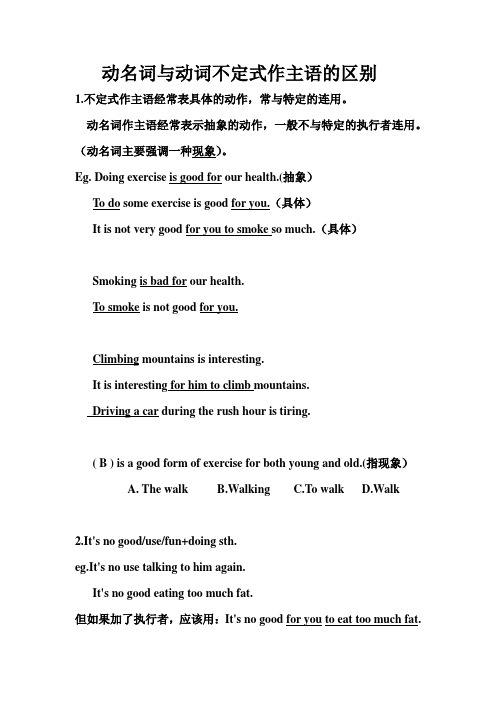
动名词与动词不定式作主语的区别1.不定式作主语经常表具体的动作,常与特定的连用。
动名词作主语经常表示抽象的动作,一般不与特定的执行者连用。
(动名词主要强调一种现象)。
Eg. Doing exercise is good for our health.(抽象)To do some exercise is good for you.(具体)It is not very good for you to smoke so much.(具体)Smoking is bad for our health.To smoke is not good for you.Climbing mountains is interesting.It is interesting for him to climb mountains.Driving a car during the rush hour is tiring.( B ) is a good form of exercise for both young and old.(指现象)A. The walkB.WalkingC.To walkD.Walk2.It's no good/use/fun+doing sth.eg.It's no use talking to him again.It's no good eating too much fat.但如果加了执行者,应该用:It's no good for you to eat too much fat.3.It is dangerous climbing a tree.It is terrible not being allowed to smoke at all.It is nice helping other people.It is interesting planning a holiday.但important,necessary,possible,impossible...等形容词不能用上述结构:eg: It's important learning foreign languages.(×)It's important to learn foreign languages.(√)4.主语与表语必须一致。
不定式与动名词作主语的区别和用法
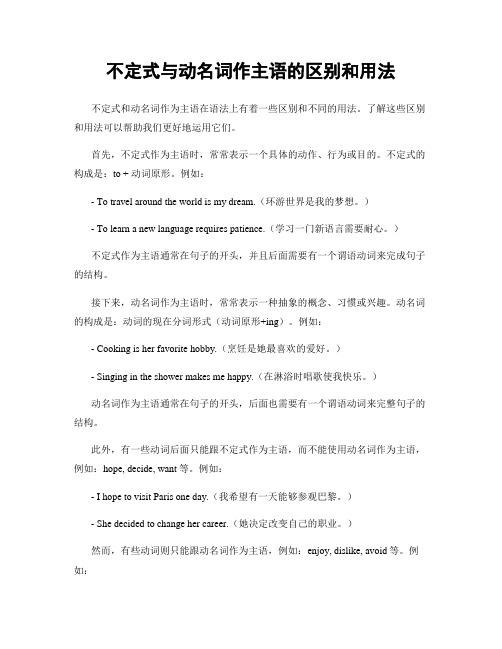
不定式与动名词作主语的区别和用法不定式和动名词作为主语在语法上有着一些区别和不同的用法。
了解这些区别和用法可以帮助我们更好地运用它们。
首先,不定式作为主语时,常常表示一个具体的动作、行为或目的。
不定式的构成是:to + 动词原形。
例如:- To travel around the world is my dream.(环游世界是我的梦想。
)- To learn a new language requires patience.(学习一门新语言需要耐心。
)不定式作为主语通常在句子的开头,并且后面需要有一个谓语动词来完成句子的结构。
接下来,动名词作为主语时,常常表示一种抽象的概念、习惯或兴趣。
动名词的构成是:动词的现在分词形式(动词原形+ing)。
例如:- Cooking is her favorite hobby.(烹饪是她最喜欢的爱好。
)- Singing in the shower makes me happy.(在淋浴时唱歌使我快乐。
)动名词作为主语通常在句子的开头,后面也需要有一个谓语动词来完整句子的结构。
此外,有一些动词后面只能跟不定式作为主语,而不能使用动名词作为主语,例如:hope, decide, want等。
例如:- I hope to visit Paris one day.(我希望有一天能够参观巴黎。
)- She decided to change her career.(她决定改变自己的职业。
)然而,有些动词则只能跟动名词作为主语,例如:enjoy, dislike, avoid等。
例如:- I enjoy swimming in the ocean.(我喜欢在海洋中游泳。
)- He dislikes cleaning the house.(他不喜欢打扫房子。
)总结一下,不定式和动名词作为主语的区别和用法在于:不定式更常表示具体的动作或目的,动名词更常表示抽象的概念或习惯;有些动词只能跟不定式作为主语,而有些动词只能跟动名词作为主语。
动词不定式和动名词作主语的区别?

动词不定式和动名词作主语的区别?动词不定式和动名词作主语的区别:
1. 动词不定式通常表⽰具体的,实际的,确切的某个事情,⽽动名词通常表⽰抽象、⼀般的事情:、
To complete the program needs much effort.
Riding a bike can make a man smart
2. 疑问句中通常⽤动名词短语作主语
Is his speaking reasonable?
3. 在⼀些习惯⽤语中,固定搭配中,⽤动名词⽽不⽤动词不定式
it is no use talking your trouble to a man like him.
it is worthwhile doing this
4. 通常主语和表语应该⽤相同的形式,如都⽤不定式或都⽤动名词
Seeing is believing
但是,在现代英语中,当表语⽤来解释或说明主语的意思或含义的时候,主语⽤动名词,⽽表语⽤不定式: Waving your hand is to say 'Good-Bye'.
"Nodding your head" is to say "Yes".。
不定式和动名词做主语的区别
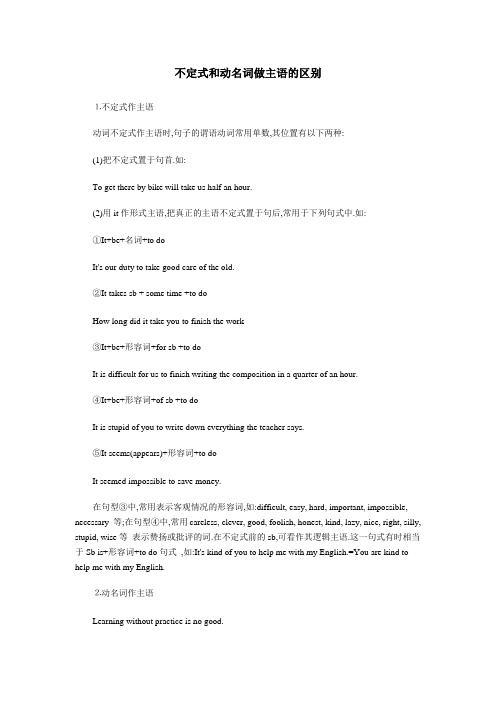
不定式和动名词做主语的区别⒈不定式作主语动词不定式作主语时,句子的谓语动词常用单数,其位置有以下两种:(1)把不定式置于句首.如:To get there by bike will take us half an hour.(2)用it作形式主语,把真正的主语不定式置于句后,常用于下列句式中.如:①It+be+名词+to doIt's our duty to take good care of the old.②It takes sb + some time +to doHow long did it take you to finish the work③It+be+形容词+for sb +to doIt is difficult for us to finish writing the composition in a quarter of an hour.④It+be+形容词+of sb +to doIt is stupid of you to write down everything the teacher says.⑤It seems(appears)+形容词+to doIt seemed impossible to save money.在句型③中,常用表示客观情况的形容词,如:difficult, easy, hard, important, impossible, necessary 等;在句型④中,常用careless, clever, good, foolish, honest, kind, lazy, nice, right, silly, stupid, wise等表示赞扬或批评的词.在不定式前的sb,可看作其逻辑主语.这一句式有时相当于Sb is+形容词+to do句式,如:It's kind of you to help me with my English.=You are kind to help me with my English.⒉动名词作主语Learning without practice is no good.动名词作主语时,也常用It句式.如:①It's +no good(no use, fun, a pleasure, a waste of time)+doing…It's no good reading in dim light.It's no use sitting here waiting.②It's+形容词+doingIt's dangerous swimming in the sea in windy days.这样用的形容词有expensive, nice, tiring等,但important, necessary则不适用于这种结构,应用不定式代替,如:It's important for you to keep fit.③There is no + doingThere is no saying what will happen next.在这一结构中,动名词后常带宾语,相当于"It's impossible to…"结构.⒊动词不定式和动名词作主语的区别①不定式作主语经常表示具体动作,常与特定的动作执行者联系在一起;而动名词作主语经常表示抽象动作,经常不与特定的动作执行者联系在一起.如:It's no good eating too much fat.It's no good for you to eat so much fat.②动名词结构作主语,可以用名词或代词属格形式作逻辑主语.如:It's no use your pretending that you didn't know the rules.不定式做主语,一般用it当形式主语,把作主语的不定式短语后置。
不定式和动名词做主语的区别

不定式和动名词做主语的区别
不定式和动名词都可在句子中作主语,一般说来, 有下面几点须给予注意:
(1) 不定式一般表示具体的、特定的行为;而动名词一般表示抽象的、一般的行为。
如:To complete the program needs much effort. 完成这项计划需要很大的努力。
Riding a bike can make a man smart. 骑单车能使一个人敏捷。
(2)不定式作主语时通常位于句首,也可把引导词it放在句首作形式主语,而把真正的主语--动词不定式(短语)放在后面。
句型为:It is +adj/n.+for/of sb to do sth。
不定式通常有逻辑主语
例:It’s not easy for me to answer this question.对我来说回答这个问题不容易。
当表语形容词表示的是逻辑主语的性质或特征时,介词用of。
例:It's very kind of you to do so.你这样做真是太善良了。
(3)在疑问句中,只能用动名词的复合结构作主语。
如:
Is his speaking reasonable? 她的说话有道理吗?
(4) 在某些句型中通常要用动名词短语作主语。
如:It is no use doing…/ It is no good doing…/ It is useless doing…/ It is worthwhile doing…如:
It is no use talking your trouble to a man like him. 跟他那样的人谈你的烦恼没有用。
动名词和不定式的区别与用法

动名词和不定式的区别与用法动名词和不定式是英语中常见的两种动词形式,它们在用法和含义上有一些区别。
本文将从几个方面探讨动名词和不定式的区别与用法。
一、形式上的区别动名词是动词加上-ing形式构成的名词,例如:swimming, reading。
而不定式则是由to加上动词原形构成的,例如:to swim, to read。
二、用法上的区别1. 主语动名词可以作为句子的主语,例如:Swimming is my favorite hobby. 不定式一般不能作为句子的主语,但可以通过在前面加上it来作为形式主语,例如:It is important to learn English.2. 宾语动名词可以作为动词的宾语,例如:I enjoy swimming. 不定式也可以作为动词的宾语,例如:I want to go shopping.3. 表语动名词可以作为系动词的表语,例如:Her favorite activity is dancing. 不定式不能作为系动词的表语。
4. 定语动名词可以作为名词的定语,例如:I bought a swimming pool. 不定式也可以作为名词的定语,例如:I have a book to read.5. 动词后的宾语动名词可以直接跟动词后的宾语,例如:She enjoys swimming pools. 不定式一般需要用介词来连接动词后的宾语,例如:She wants to go to the swimming pool.6. 动词的完成形式动名词可以和完成时态连用,例如:I regret not studying harder. 不定式不能和完成时态连用,例如:I regret not to have studied harder.三、意义上的区别1. 动名词表示正在进行的动作或习惯性的动作,强调动作本身。
例如:I enjoy swimming. (我喜欢游泳)2. 不定式表示将来的动作或目的,强调动作的目的或意图。
动词不定式和动名词作主语的区别

⒊动词不定式和动名词作主语的区别①不定式作主语经常表示具体动作,常与特定的动作执行者联系在一起;而动名词作主语经常表示抽象动作,经常不与特定的动作执行者联系在一起.如:It's no good eating too much fat.It's no good for you to eat so much fat.②动名词结构作主语,可以用名词或代词属格形式作逻辑主语.如:It's no use your pretending that you didn't know the rules.,作宾语⒈不定式作宾语①以下动词后,只能跟不定式作宾语.如:agree, ask, aim, arrange, choose, decide, demand, expect, fail , help, hope, lean, long, manage, offer, plan, prepare, pretend, promise, refuse, wish等,这些词大部分可接that引导的从句.如:I decided to ask for my money back.I decided that I would ask for my money back.When our visit to the farm was over, we expected to start back on foot.When our visit to the farm was over, we expected that we would start back on foot.②当复合宾语中的宾语是不定式时,先用形式宾语it代替不定式,把不定式置于补语之后,即:主语+动词+it+补语+to do句式.如:We think it quite important for us to learn a foreign language well.He feels it his duty to help the poor.③介词but, except, besides +to do(do)在这种句型中,如介词前有动词do,后面应接不带to的不定式;如无do,则接to不定式,即带do不带to, 带to不带do.如:The enemy soldiers had no choice but to give in.On Sunday afternoon I had nothing to do but watch TV.⒉动名词作宾语①以下动词后,只能接动名词作宾语,如:admit, appreciate, consider, delay, enjoy, finish, keep, imagine, mind, miss, practise, resist, risk, save, suggest, don't mind, give up, insist, on, put off等.如:I suggest spending our summer vacation in a seaside town.You must give up smoking, for it does too much harm to your health.②动名词作介词的宾语I should go to attend the birthday celebration instead of staying at home.What about inviting Li Jun to make a speech动名词前的介词有时可以省略,如:have difficulty(in)doing, have no trouble(in)doing, lose no ti me(in)doing, prevent/stop…(from)doing, there is no use(in)doing等.⒊部分动词后面,既可接动词不定式,也可接动名词作宾语,意义不变.如:begin, continue, start, hat e, like, love, need, require, want等.在need, require, want后接-ing形式,表示被动意义,也可接不定式,但要用被动形式,如:Your handwriting needs improving (to be improved). hate, love, like接不定式表示特定的未来事件,接动名词表示目前正在进行的活动或一般的行为.在下列情况下,一般要用不定式:①hate, like, love前有would(should)时,如:I'd like to have a cup of coffee.②当谓语动词begin, continue, start等是进行式时,如:The students are starting to work on the difficult maths problem.③begin, continue, start与know, understand等状态动词连用时,如:I soon began to understand whatwas happening.⒋advise, allow, encourage, forbid, permit等动词后接动名词作宾语,或带不定式作宾语补足语.如:Our teachers don't permit our swimming in the lake.Our teachers don't permit us to swim in the lake.⒌部分动词后接不定式或动名词时,意义差别较大,应根据句子语境选择使用.①forget, remember, regret后接不定式,表示现在或未来的动作,接动名词表示动作已经发生.如:Don't forget fo post the letter for me.Have you forgotten meeting her in Beijing AirportRemember to close the windows before you leave.I remember writing him a letter a year ago.We regret to tell you that all of you are not invited to attend the meeting.They regretted ordering these books from abroad.②mean to do 打算做某事doing 意味着……I meant to catch up with the early bus.This means wasting a lot of money.③try to do 设法尽力做某事doing 试着做某事You should try to overcome your shortcomings.Try working out the physics problem in another way.④stop to do 停下一件事去做另一件事(不定式作目的状语)doing 停止做某事On the way to the airport, I stopped to buy a paper.You'd better stop arguing and do as you are told.⑤can't help doing 禁不住……to do不能帮助干……They couldn't help jumping up at the news.Sorry I have lots of work to do. So I can't help to make up the room for you.⑥go on to do 做不同的事或不同内容的事doing 继续不停地做某事,指同一动作的继续He went on to talk about world situation.他接着又谈了世界形势.We'll go on fighting so long as there is oppression in the world.⑦leave off to do 离开某地去干什么(目的状语)doing停下某事It's time to leave off talking and to start acting.They left off to go fishing.三,做表语不定式作表语表示具体动作或将来动作;动名词作表语表示抽象的一般行为.①To be kind to the enemy is to be cruel to the people.②My chief purpose is to point out the difficulties of the matter.③What I would suggest is to put off the meeting.当主语和表语都是不定式时,其含义一是条件,一是结果(例①).当主语是aim, duty, hope, idea, mistake, plan, purpose, suggestion等为中心词的名词词组(例②)时,或以what引导的名词性分句(例③),不定式说明主语的内容.④Our work is serving the people.⑤What he likes is taking a walk after supper.⑥The story told by Mr. Wang is interesting.④⑤句动名词作表语,与主语部分可以转换,如Serving the people is out work, 而⑥句中是现在分词作表语,说明主语的性质,状态,现在分词具有形容词的各种特征,另外,动名词作表语还应与进行时态区别开来.四,作定语⒈不定式作定语不定式在句中作定语,置于被修饰的名词或代词之后.如:①The next train to arrive is from Washington.②Have you anything to be taken to your sister③Do you have anything to say on the question④Would you please give me some paper to write on⑤My wish to visit France has come true at last.不定式短语作定语和被修饰词之间表示以下关系:(1)表示将来的动作(例①).(2)与被修饰词之间有动宾关系,如是不及物动词,则需加介词(例④).(3)与被修饰词之间有动宾关系,同时与句中其它词之间又有逻辑上的主谓关系时,尽管有被动含义,却仍用主动语态(例③);如只有动宾关系,而无逻辑上的主谓关系,则需用被动语态(例②).(4)不定式作定语时,一般可转换为定语从句,例①to arrive=that will arrive.⒉动名词作定语①This passage can be used as listening materials.②The reading room of our school library can hold 800people.③All moving bodies have energy.①②句动名词作定语说明一种性能,即:用来……的;第③句为现在分词作定语,单个分词作定语常置于被修饰词之前,与被修饰词之间,可构成逻辑上的主谓关系,分词短语作定语常置于被修饰词之后.如:The man standing at the school gate is Professor Hua.五,不定式作补足语⒈作宾语补足语一些及物动词除要求按宾语外,有时还需要有宾语补足语,说明宾语的行为,状态,特征,这时意思才相对完整.(1)常要求不定式作宾补的动词有:allow, ask, advise, beg, cause, drive(强迫),encourage, expect, forbid, force, get, would like(love, hate), order, permit, persuade, teach, tell, want, warn, wish等.如:①Would you like me to give your regards to Mary②I want you to understand the whole passage clearly.(2)部分动词后常接to be+形容词,名词短语等形式,有时to be可省略,如:believe, consider, discover, find(=consider), feel(=think), imagine, judge, know, prove, think, suppose,see(=understand), understand等.①We all believe John(to be)honest.②I consider him(to be)one of the best biology teachers of No. 1 Middle School.但当不定式是完成式时,to不能省略,如:We consider him to have been foolish.(3)感觉动词和使役动词后用作宾补的不定式须省略to.①I didn't hear anyone say anything about it.②They make the students do too much homework every day.这种句式在变为被动语态时,to不能省略,如第②句:The students are made to do too much homework every day.(4)help, know后面的"to"可有可无.如:Would you please help me(to) fill in the tax formI've never known her(to)be late before.但:He was known to have been to France before.(5)部分短语动词后,常接不定式作宾补,如:You may depend on them to be there early.The Party calls on us to increase production and practise economy.常这样用的短语动词有:ask for, care for, call on, count on, depend on, wait for, long for(渴望), prepare for, wish for等.⒉作主语补足语不定式作主语补足语,和主语构成一种逻辑上的主谓关系.如:①He was not allowed to enter the classroom for being late.②The young university student is considered to have great promise.六,不定式作状语⒈作目的状语(1) ①I stayed there to see what would happen.②Henry has decided to go to the hospital to be examined by the doctor.(2)有时为了强调,不定式前可加in order或so as.如:Bob took down my telephone number so as(in order)not to forget it.有时为强调目的状语可把in order to或不定式置于句首,但so as to不能这样用.在这种句式中不定式部分可转换为so that, in order that, 成为目的状语从句,如:I stayed there so that (in order that)I could see what would happen.(3)在部分表示感情色彩的形容词,过去分词或动词之后可接不定式,如:astonished, glad, happy, laugh , pleased, sad, smile, sorry, surprised等.①We are glad to hear the news.②I was surprised to see that a three-year-old baby could write so well.在部分形容词后接不定式,用主动形式表示被动意义,这种句型中的主语是不定式的逻辑宾语.如:The question raised by the student is difficult to answer.The room is really comfortable to live in.常这样用的形容词有:comfortable, easy, dangerous, difficult, expensive, fit, impossible等.⒉作结果状语We came home after our holiday to find our garden neat and tidy.不定式作结果状语还常用在下列句式中.如:①so…as to; such…as toI'm not so stupid(a fool) as to put it in writing.我不至于愚蠢到会把它写下来.I'm not such a stupid fool as to put it in writing.②enough…t oThe speed is high enough for us to catch up with the first liner.③only toJane hurried back only to find her mother dying in the hospital.④too…toI'm too tired to stay up longer.但在下列结构中,too…to并非是"太……而不能……"之意.如:①I'm only too glad to have passed the exam.考试及格我太高兴了.(too修饰glad to have…,相当于very)②We have too much to learn.我们要学的太多了(不定式作定语).⒊不定式短语还可作独立成分,用于句首,句中或句末.如:To tell the truth, the play was a great disappointment tome.常见的短语有to be exact(确切地说),to begin with(首先),to do him justice(说句对他公道的话),to be sure(真的)等等.七,动词不定式,动名词的其它用法⒈疑问词+不定式结构疑问词who, what, which, when, where, whether, how后可接不定式构成不定式短语,在句中作主语,宾语,表语等.如:①When to leave for London has not been decided yet.②Mr. Smith didn't know whether to leave or stay there.③I asked Professor Xu how to learn English well.④The question was where to get the medicine needed.以上例句中疑问词+不定式部分,均可转换为相应的从句形式.如:①When we shall leave…③…how Icould learn…经常在这种结构中使用的动词有:consider, decide, discover, explain, find out, forget, hear, know, lea rn, observe, understand, wonder等.⒉动词不定式的时态,语态(1)时态①一般式:动词不定式一般式表示的动作发生在谓语动词之后,有时表示同时发生.如:I hope to become a university student this year.(to become发生在hope之后)We often hear Dick play the piano in the next room.(play和hear同时发生)②完成式:表示的动作发生在谓语动词所表示的动作之前.如:I'm sorry to have kept you waiting.We are too young to have seen the old society.③进行式:表示的动作与谓语动词同时发生.如:The teacher happened to be correcting our papers when I came in.They seemed to be discussing something important.(2)语态如果动词不定式的逻辑主语是这个不定式所表示的动作的承受者,不定式一般要用)want to do sth 想要做某事want sb to do sth 想要某人做某事turn to sb for help 求助于某人(这算不定式?)help sb (to) do sth 帮助某人做某事It is dangerous to do sth 做……是危险的want to be 希望从事什么职业stop to do sth 停下来去做某事remember to do sth 记得去做某事forget to do sth 忘记去做某事love to do sth 喜爱做某事would like to do sth 想要做某事would like sb to do sth 想要某人做某事(I would= I'd)practice doing sth 练习做某事spend(time/money) in doing sth 花时间或钱做某事spend补充spend...on sth 在某物上花多少钱go to do sth 去做某事watch sb do sth (省略to)看见某人做某事(全过程)It's time to do sth 做……事的时间到了(=It's time for sth)decide to do sth 决定做某事agree to do sth 同意做某事have to do sth 不得不做某事动名词like doing sth 喜欢做某事(经常)enjoy doing sth 喜欢做某事be busy doing sth 忙于做某事(=be busy doing sth)be doing sth (现在进行时)thank sb for doing sth 谢某人做了某事(=thank sb for sth)remember doing sth 记得做过某事forget doing sth 忘记去做某事stop doing sth 停止做某事huan fun doing sth 做某事有乐趣do some +V.ing 做某事What about doing sth 做某事怎么样?(=How about doing sth)watch sb doing sth 看见某人正在做某事find sb/sth doing sth 发现某人/物在做某事(这个有点疑问,参考书上说强调结果,一般不用进行时态?)discuss doing sth 讨论做某事go doing 去做某事What do you think of doing sth 你认为做某事怎么样?原形let sb do sth 让某人做某事make sb do sth 让某人做某事help sb (to) do sth 帮助某人做某事。
- 1、下载文档前请自行甄别文档内容的完整性,平台不提供额外的编辑、内容补充、找答案等附加服务。
- 2、"仅部分预览"的文档,不可在线预览部分如存在完整性等问题,可反馈申请退款(可完整预览的文档不适用该条件!)。
- 3、如文档侵犯您的权益,请联系客服反馈,我们会尽快为您处理(人工客服工作时间:9:00-18:30)。
不定式和动名词作主语的区别:
(1) 动名词作主语通常表示抽象动作;而不定式作主语表示具体
动作。
Smoking is prohibited(禁止)here.这里禁止抽烟。
(抽象)
It is not very good for you to smoke so much.你抽这么多烟对你
身体很不好。
(具体)
(2) 动名词作主语时,通常用以表示一件已知的事或经验。
不定
式短语通常用来表示一件未完成的事或目的。
Climbing mountains is interesting.爬山很有趣。
(经验)
Driving a car during the rush hour is tiring.在高峰时刻开车令
人厌烦。
(经验)
To finish the task will take a long time.要完成这项任务将要花
费很长时间。
(具体)
(3) 不定式做主语,一般用it当形式主语,把作主语的不定式短
语后置。
It took me only five minutes to finish the job.
(4)动名词做主语往往表示普通的,一般的行为;不定式作主
语常常表示某次具体的行为。
Collecting information about children's health is his job.
收集有关儿童健康的信息是他的工作。
It’s necessary to discuss the problem with an experienced teacher. 与一位有经验的老师讨论这个问题是有必要的。
2、常用不定式做主语的句型有:
(1)It’s difficult (important, necessary) for sb. to do
(2)It’s kind (good, friendl y, polite, careless, rude, cruel, clever, foolish, brave) of sb. to do.
3、常用动名词做主语的句型有:
It’s no good (use, fun) doing.
It’s (a) waste of time one’s doing.。
